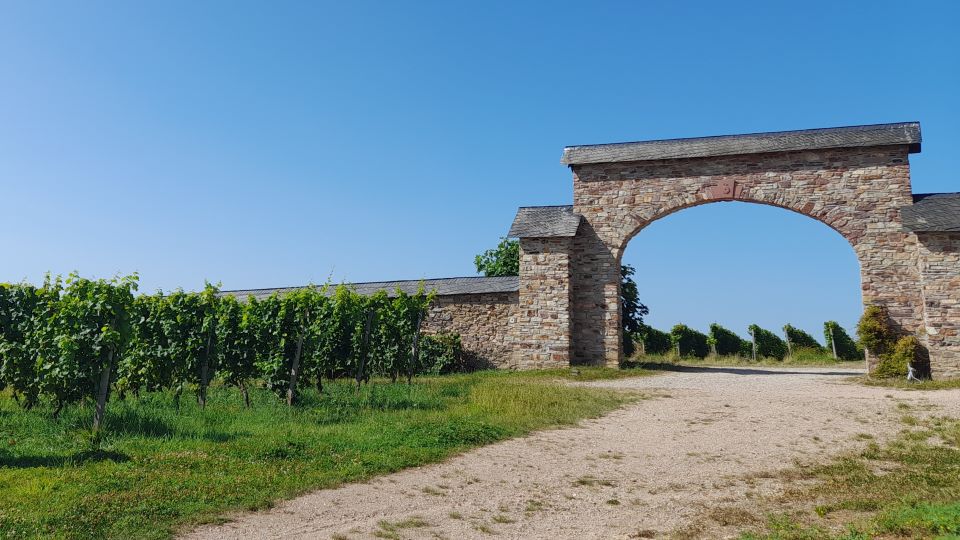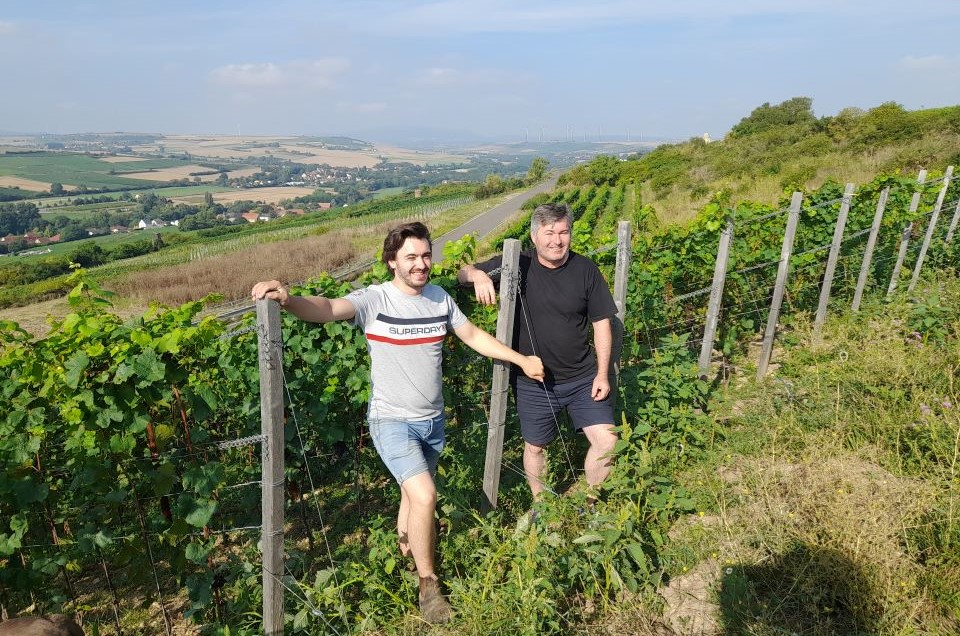Browse using the new Vinous website now. Launch →
Printed by, and for the sole use of . All rights reserved © 2015 Vinous Media
Rheinhessen & Rheingau: Riesling Triumphs After Rain
BY ANNE KREBIEHL MW | OCTOBER 03, 2024
Rheingau and Rheinhessen produced world-class
Rieslings in 2023. The wines are bursting with flavor and delineated by
freshness, but moderate in alcohol. “The nectarine and curious peach into my
hands themselves do reach…” This striking line from Andrew Marvell’s poem The
Garden involuntarily popped into my mind repeatedly while tasting the 2023
Rieslings; such was their verve and expression. Even the entry-level Rieslings
shine. However, the year was not an easy one.

The entrance to the historic Steinberg Vineyard at Kloster Eberbach.
Viticultural skills, timely decisions and a sufficient workforce were needed to capture the brilliant fruit. An initially dry year was drenched in late summer rains, which the late-ripening Riesling weathered with aplomb–at least in the right hands and sites. The steep, stony slopes of historic renown proved their exalted status all over again, and so did well-drained, gentler slopes. Water availability advanced ripeness as well as aromatic development, and if there is one operative attribute for this Riesling vintage, it is juiciness. In the Rheingau, off-dry and nobly sweet wines with electric acidity are an added bonus. Some of them will outlive us all. The 2022 Pinot Noirs are among the best German Spätburgunders ever made.
The 2023 Rheinhessen Growing Season
Rheinhessen is a vast and diverse growing region, offering the coolness of Tertiary limestone in its southern Wonnegau, the savor of iron-rich Permian Rotliegendes on the Red Slope on its western confine along the river Rhine, and a diverse patchwork of geological formations in its north and northwest–encompassing quartzite, porphyry and more limestone. All of these find beautiful expression in 2023. Daniel Wagner of Weingut Wagner-Stempel in Rheinhessen’s far northwest sketched the year: “A wonderfully dry spring gave us excellent flowering conditions in late May and early June, without millerandage. While we entered the year with good water reserves, the weather turned extremely dry. We already feared we would have to water the young vines. Then, on July 8, we got 50 liters (50mm) of rain. We opened a bottle of Champagne to celebrate. It was a very local event, and everyone envied us. Two weeks later, however, the picture was different because the rain never stopped.” Wagner says this was a “catastrophe” for the early-ripening varieties but a boon for Riesling. Weiss and Grauburgunder were soft and riper, and the already tightly packed berries on the grape bunches had no room to swell, so they burst and opened themselves to rot. Speed was of the essence. Riesling, however, less advanced in ripeness, could take advantage of the water availability and continued ripening, resulting in radiantly beautiful fruit.
In the Selztal in Rheinhessen’s north, where Tertiary limestones are mixed with marl, loess and clay, Tobias Knewitz described the situation after a rain-drenched August as “tense.” The combination of wet weather and high temperatures turned the harvest into a race against time that required the most stringent selection–again, with Riesling far less affected than earlier-ripening varieties.

Andreas Spreitzer with his collection of 2023s.
At the other end of the region, in the southerly Wonnegau where Tertiary limestones dominate, Philipp Wittmann reported a “very balanced warm summer with great water availability.” The rains prompted him to advance his harvest as the combination of warm weather and water availability spelled fast-advancing ripeness. The Battenfeld-Spanier estate was hit by hail in their Hohen-Sülzen sites in the night from August 25-26, 2023–thankfully not in the Grosse Lagen. It struck again, unusually in Hohen-Sülzen, on September 10 but mainly hit sites that had already been picked.
On the Rheinfront across the Red Slope, Johannes Hasselbach reported a relaxed mood during a dry summer that was “warm but not hot.” For him, the rain at harvest was the only difficulty of the year, prompting an intense sorting effort that was rewarded with exquisitely aromatic wines.
Across Rheinhessen, picking started mostly in early and mid-September and concluded within the month, with just a few estates still finishing in early October. Despite the challenging vintage, few people complained; the memory of the very dry 2022 is too vivid, and most felt lucky to have escaped hail episodes in late August and September. Sufficient water meant that grapes had enough minerals to ferment without any hitch. The 2023 growing season resulted in wonderfully expressive Rieslings with immense freshness and aromas. Sure, some estates cannot afford to hand-harvest or invest so much in viticulture–for them, the wet August spelled disaster, but the estates reviewed here produced outstanding results. Klaus Peter Keller summed this up in his brief statement that “two thousand twenty-three is a vintage that made good growers better and the poor ones worse. You can make great wine every year if you are strict enough, but you have to be able to afford this.”
Estates with a history of producing sweet wines could harvest fine Spätlesen and Auslesen. I only tasted two Beerenauslesen–the highest Prädikat as the wet weather did not allow the grapes to dry out fully.

Father and son, Klaus Peter and Felix Keller, showing off their high-density plantings.
The 2023 Rheingau Growing Season
The Rheingau saw a year of “extremes,” as Wilhelm Weil put it. Budburst in late April was in line with long-term averages, as was flowering in good conditions in early June with a good fruit set. But June and July brought dryness and heat, which stressed poor, stony sites. The August rains initially felt like relief but soon turned to worry and hurry as this was combined with a heatwave in early September. Katharina Puff of Kloster Eberbach described the conditions as “tropical.” Michael Burgdorf of Weingut Dr. Wegeler reported that “rarely has there been such a hot September and October. The fact that there was no further rain in September was a supreme stroke of luck.” Extreme selection defined the relentlessly quick and intense harvest. The musts were characterized by expressive but ripe acidity and high extract, as the rain had given the grapes everything they needed; fermentations were easy. Fred Prinz noted that the warm weather at harvest meant that some musts started fermenting readily even before they were fully sedimented after pressing.
In the vineyards, moisture, temperatures and ready ripeness also favored the development of botrytis. Where soils afforded drainage and canopies were ventilated, long-lived sweet grapes could be harvested, covering the full range of Prädikate. What makes them historic are their thrilling acid levels: Spreitzer’s TBA from the Eiserberg, an airy parcel within the Oestricher Lenchen, clocked up 18g/l (!) of acidity vis-a vis 323g/l of residual sweetness. Robert Weil presented very sweet Auslesen, BAs and TBAs with acid levels well above 10g/l. The acids in these wines are like laser lights illuminating every last nuance of flavor. However, Kabinette and Spätlesen in 2023 are of immense purity and luminosity–without any botrytis at all. These are exquisite, pure wines that will be almost as long-lived as those concentrated by the presence of botrytis. In 2023, Rheingau demonstrated exceptional capabilities, producing a wide range of Riesling styles.
As machine harvesting is widespread in Rheingau, and hand harvest is now the exception rather than the rule, I must qualify my praise by saying that only the best estates have achieved such quality–like the ones visited here. They delivered Rieslings of uncommon brilliance and expressiveness with a fill of fruit and moderate alcohol.

Fritz Groebe has a knowing and relaxed smile after the tasting. He is a man who has found his style and groove.
A Word on Spätburgunder
Two thousand twenty-two provides a new paradigm for German Pinot Noir. The wines from this hot and dry year do not taste hot at all. On the contrary–the top producers have understood the importance of harvest point. Dry conditions meant perfectly healthy grapes, and despite the usual German spectrum of styles, these Pinot Noirs are distinguished by their really fine, ripe tannin structures. Neither are they drowned in oak. Elegance is now a byword and readers looking for alternatives to Burgundy will find a most contemporary interpretation of an old-world style in Germany. In addition to Pinot Noirs from limestone, Germany offers beguiling expressions of this grape from slate, schist, sandstone and volcanic soils.
The wines in this report were tasted during producer visits in August 2024.
© 2024, Vinous. No portion of this article may be copied, shared or re-distributed without prior consent from Vinous. Doing so is not only a violation of our copyright, but also threatens the survival of independent wine criticism.
You Might Also Enjoy
2022 Rheingau, Pfalz and Mittelrhein: Before, During and After the Rain, Anne Krebiehl MW, December 2023
2022 Mosel-Saar-Ruwer: Old Vines and Steep Challenges, Anne Krebiehl MW, October 2023
2022 Rheinhessen & Nahe: Rain in the Nick of Time, Anne Krebiehl MW, September 2023
Show all the wines (sorted by score)
- Adamswein
- August Kesseler
- Battenfeld-Spanier
- Bibo Runge
- Braunewell
- Chat Sauvage
- Corvers-Kauter
- Eva Fricke
- Fritz Ekkehard Huff
- Fürst von Metternich
- Georg Breuer
- Groebe
- Gunderloch
- J. Neus
- Josef Spreitzer
- Kai Schätzel
- Karl May
- Keller
- Kloster Eberbach
- Knewitz
- Krone Assmannshausen
- Kühling-Gillot
- Künstler
- Leitz
- Peter Jakob Kühn
- Riffel
- Robert Weil
- Saalwächter
- Schloss Johannisberg
- Thörle
- Von Oetinger
- Wagner-Stempel
- Wegeler
- Weingut Kaufmann
- Weingut Prinz
- Weingut Weedenborn
- Wein- und Sektgut Barth
- Wittmann
